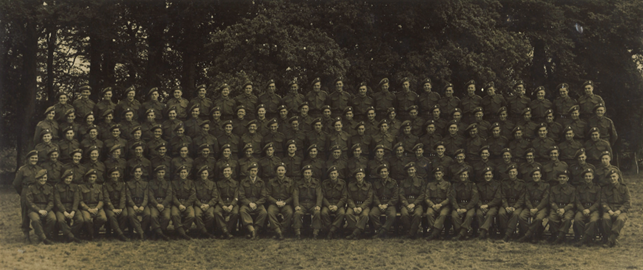
A Battalion War Diary can often throw up an intriguing snippet that often invites further investigation and perhaps pause for thought. The British Army based at home between the long wait between Dunkirk and D-Day, trained, carried out exercises and continued to guard against German attack. The 5th Battalion Duke of Cornwall’s Light Infantry (DCLI) were based in the Sandown area on the Isle of Wight from January to April 1943.
On 8th March, fortune favoured a Pilot Officer of the Fleet Air Arm who was found in the dark by a patrol from ‘D’ Company, the Officer had crashed into the sea and had drifted ashore after five and a half hours at sea in his rubber dinghy.
It is interesting to speculate what life that Officer led after his good fortune, did his luck continue, did he have a family? If only there was a name. What of his rescuers? The page from the War Diary is brief and to the point with little embellishment.
After much searching on the internet the aircraft that appears to have been lost was a Swordfish II, serial number HS313 flown by Reg Singleton of 836 Squadron Fleet Air Arm, unfortunately his two comrades lost their lives. Details on this website state that ‘Reg Singleton returning from Cherbourg at the same time as a German air raid, found himself blinded by our own searchlights which at his slow speed stayed with him, forcing him to ditch. After five hours in the dinghy in the Channel he was picked up and taken to the Isle of Wight’ and ‘Sadly, his Observer Billy Muir, and his Air Gunner L/A George, were both drowned.’
Reg Singleton seems to have survived the war, ‘Reg Singleton and his wife Kathleen had taken a flat in the High Street while they awaited not only demobilisation but the arrival of their first born.’
Unfortunately, brilliant as this information is it will not give us the names of the rescuers, the individual who spotted the raft and saved a life. The best we can do is show a collective image of members of D Company, taken at Crowhurst Park in May 1944 before the Battalion prepared to depart for Normandy. It is quite possible that even this image does not show the rescuers.
We know the fate of some of these men and perhaps someday their whole story will be told. Perhaps for the present they represent all those who fought in the bitter and hard fighting in Normandy in June, July and August 1944.

Front row L to R, L/Cpl West, Cpl Hoskin, Hill, Fogg, Chapman, Cooley, Sjt Savery, McTimoney, CSM Noble, Lt Lough, Capt Jobson, Maj Fry, Capt Hopkins, Prowse, Lt Commoli, CQMS Kilbourne, Sjt Johnson, Cpl Bennet, Varcoe, McCormack, Millington, L/Cpl Cowling, Belsom, Nelson-Ward.
Second row L to R, Pte Brand, Ricketts, Radcliffe, Ponting, L/Cpl Green, Pte Bailey, Tucker, Griggs, Whitard, Taylor, L/Cpl Green, Clus, Daniels, Pte Hall, Brown, Webber Tippet, Shea, Drew, James, Beagley, L/Cpl Carne, Pte Paine, Dadda, Smith, L/Cpl Gillett, Jury.
Third row L to R, Pte Brawn, Davies, Barret, Chambers, Waddington, Quick, Warner, Bone, Harris, Brown, P Bosley, Hendry, Hedgeworth, Williams, Stratton, Bones, Seeney, Cross, Merrett, Parker, Willmot, Saunders, Hodgson, Abrahms, Orchard.
Fourth row L to R, Pte Rosecrudge, Mitchel, Curtis, Bishop, Parish, Colbran, Davis, Watts, Rolston, Rowley, Trembath, Carter, Everett, Cheseman, Bastin, O’Dowd, Lucas, Jeff, Chad, Parry, Follett, Harvey, Jefferies, Cfn Spinney.
Back row L to R, Pte Bullock, Ronan, Field, Hine, Davis, Price, Brown, Grocock, Rawle, White, Pinnal, Finch, Griffins, Selway, Dymone, Ryman, Taylor, Perkins, Mathews, Davis, Jennings, Hawker, L/Cpl Northcott, Pte Pearce.
